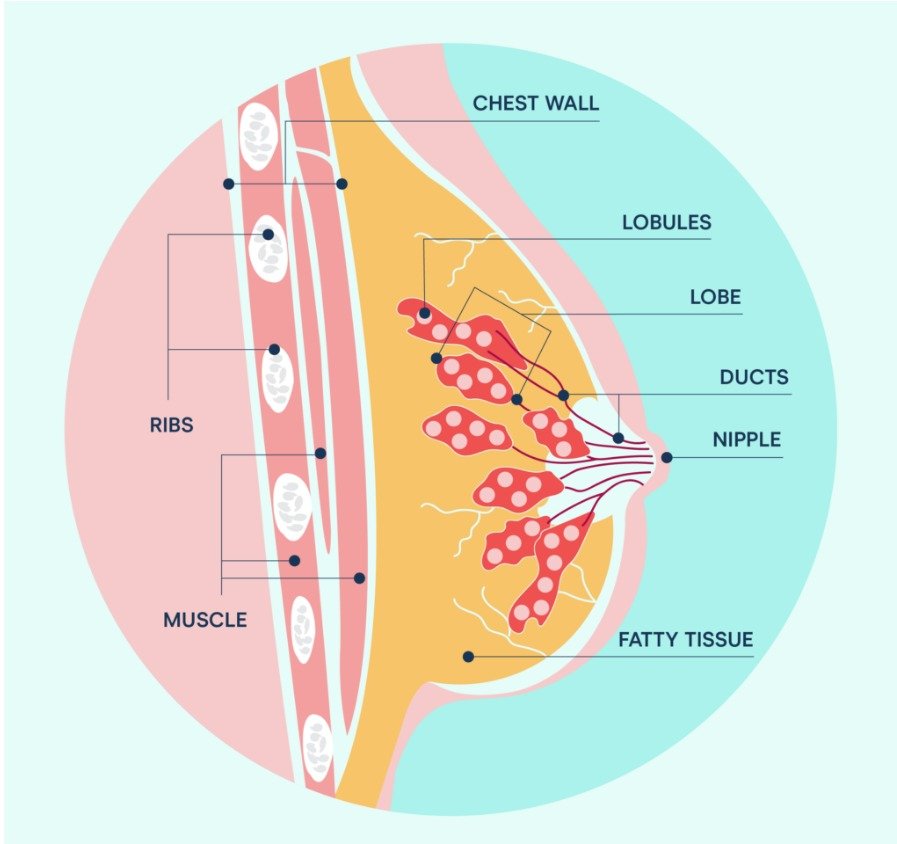Breast Cancer Causes, Risks, and Symptoms!
By: Kaytlin Kelly
In the United States, breast cancer is the most common cancer in females (except for skin cancers), resulting in about 1 in 3 females being diagnosed with breast cancer. According to the American Cancer Society, it is anticipated that in 2023, about 43,700 people will die of breast cancer. As common as breast cancer is, knowing what preventative steps to take and when to take them is crucial.
Types of Common Breast Cancers
The two most common types of breast cancer are Invasive Ductal Carcinoma and Invasive Lobular Carcinoma. A breast is made up of lobules (glands that produce milk), ducts (carry the milk from glands to the nipple), and connective tissue (protects and secures everything). The difference between ductal and lobular carcinoma is where cancer starts, either in the ducts or lobules, and both can then metastasize (spread) to other parts of the body if not caught early.
Who Can Get Breast Cancer?
Anyone can get breast cancer. Although breast cancer is most typically talked about in cisgender women (that is, women who were assigned female at birth and identify as women), everyone has some breast tissue regardless of their sex or gender identity. As a result, anyone can get breast cancer. At Bridgercare, we are commited to seeing and testing anyone who may have a breast lump or concern, regardless of their sex or gender identity.
Do Lumps in the Breasts Always Indicate Cancer?
The short answer is no, not at all. Everybody is different, and what may be abnormal for one person may not be for another. According to the Centers for Disease Control and Prevention, cysts and Fibrocystic breast disease are two noncancerous causes of breast lumps. Little fluid-filled sacs called cysts can develop in the breast. Fibrocystic breast disease can cause breast lumps, tenderness, and soreness.
Symptoms of Breast Cancer
Some people with breast cancer may or may not experience the symptoms listed below:
Newly discovered breast or armpit lump
Red spots or peeling skin on the breast
Discomfort in the breast region
Blood or other secretions from the breasts other than breast milk
Read this to learn how to give yourself a breast exam at home: Breast Self-Exam*
*Please note that home breast exams do NOT replace mammography!
Causes of Higher Risk
People over the age of 50 are at higher risk for developing breast cancer.
People who began menstruation before the age of 12 and who began menopause beyond the age of 55 have an elevated risk.
People with breasts who have had earlier therapy that involved radiation to the chest or the breasts before the age of thirty are more likely to develop breast cancer.
While certain elements cannot be avoided, others can be changed to lower breast cancer risk.
Some of the best ways that you can decrease your risk of getting breast cancer is through lifestyle changes such as:
Eating a diet rich in vegtables and lower in meats (especially red meats)
Exercising regularly
Avoiding smoking cigarettes
Limiting your intake of alcoholic beverages
Recommendations, Screening Tests, and Costs
The United States Preventative Services Task Force suggests that people with breasts who are aged 40 to 74 should have a mammogram every two years.
The two most common screening tests are mammograms and breast magnetic resonance imaging (MRI). An X-ray of the breast is called a mammography. For most who are being screened for breast cancer, mammography is the most effective detection method. When screening people at high risk of developing breast cancer, a breast MRI is performed in addition to a mammogram.
The Centers for Disease Control and Prevention says that at the age of 40, mammograms must be paid for by most health insurance plans every one to two years with no out-of-pocket expenses (such as a co-pay, deductible, or co-insurance).
There is hope!
According to the National Breast Cancer Awareness Foundation, the five-year relative survival is 99% when breast cancer is detected in its earliest, isolated phases. There are already over 3.8 million breast cancer survivors in the United States thanks to recent considerable increases in early diagnosis and treatment approaches. If you have any questions regarding symptoms or screening, schedule an appointment with one of our providers!



